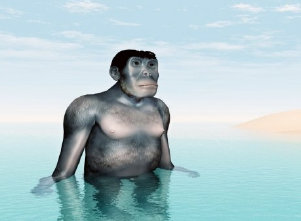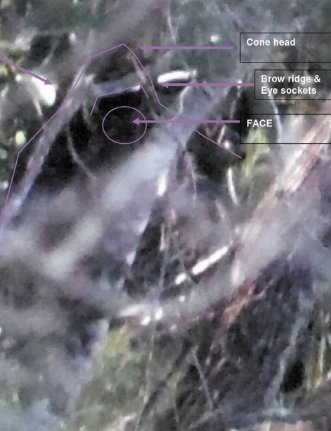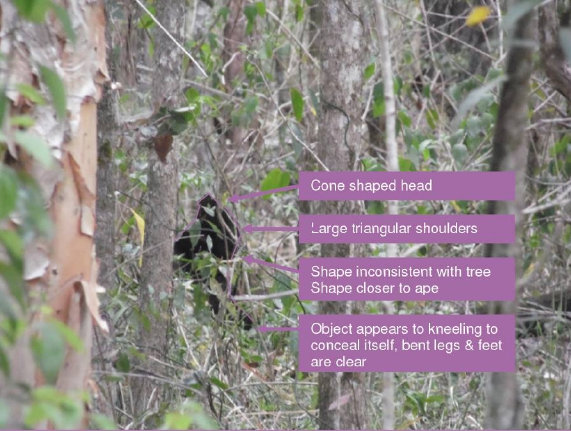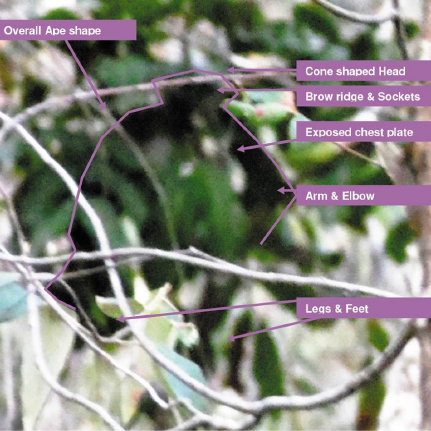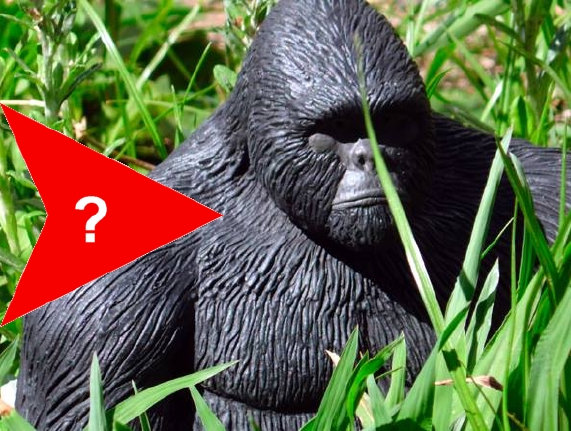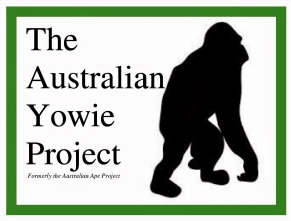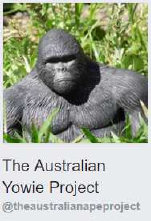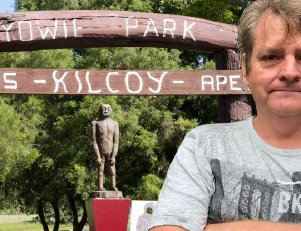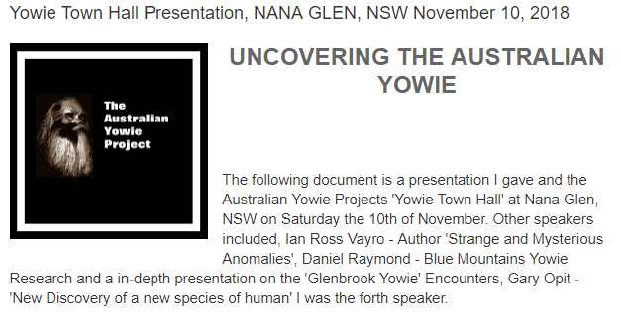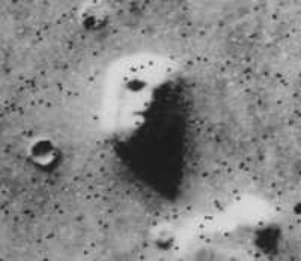

The town of Nana Glen (‘Nana’ pronounced like ‘banana’) population 1,055, was named in 1879 in part after a two-tailed lizard with
‘nana’ meaning ‘two’ in the local aboriginal dialect. Although this cryptozoological conference focused specifically on the Yowie
it was somewhat disappointing that Nana Glen’s own cryptid did not even get a cursory mention from the local cryptozoological speakers.
The
first speaker’s talk was a rollicking ride although somewhat disjointed. The next speaker from the Blue Mountains focused almost solely
on some purported shape that appears briefly in one of their videos and their on-site investigation to determine its Yowie-ness. In
the end it remains a brief low-resolution visual recording anomaly that was not noticed at the time in the field and only noticed
after repeated viewings zoomed-in while in super slow-motion. Apparently, it’s the in-thing to do at the moment to acquire potential
Yowie evidence.
It should be noted that the third speaker is not a “biologist” and did not introduce himself as one but was nevertheless
advertised for this conference as a “biologist” by the organisers. A little fact-checking wouldn't go astray here, guys. While this
speaker does have a vast practical knowledge and experience of native wildlife he instead uncritically presented a potentially significant
skeletal find by a pair of untrained ‘alternative’ authors. While the uncovered skulls appear somewhat unusual in appearance they
are very similar to other ‘unusual’ indigenous skulls (like those from Kow Swamp) found previously and yet those ones are still all
from modern humans. Instead of raising concerns about the appropriateness or even legality of these human skulls being handled by
unskilled amateurs, the speaker linked them to the Denisovans of modern archaeology via the outdated theory of the aquatic ape and
the pseudo-anthropological theory of Neanderthals having been cannibalistic Bigfoot-like by Danny Vendramini.
The main
and final speaker’s presented new information on the Yowie via a new interpretation of one of his 2014 photos of a supposed Yowie
taken at Coochin Creek, Qld, known as the “Tree Sitter”.
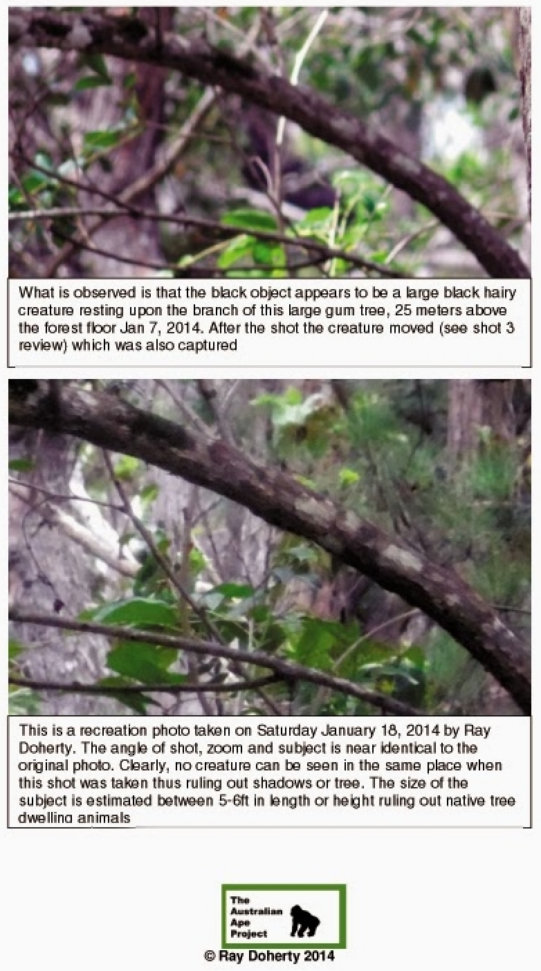
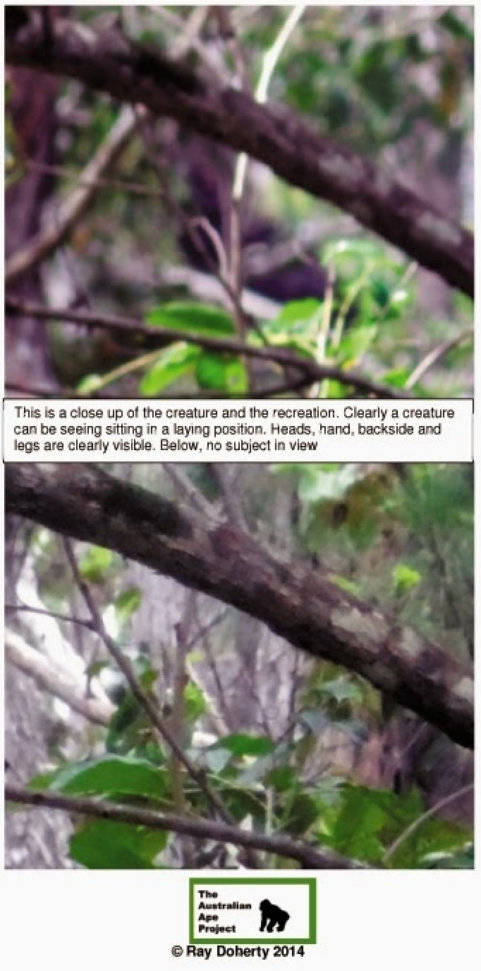
The speaker lays out his reasoninng along with the zoomed-in sections of a series of photographs above. The suspicious dark shape seemingly disappears in the second photograph meaning it was a tangible thing that moved. New previously unseen details emerge after zooming in ultra-close to what is assumed to be the “head” of the “creature” and applying a new editing program to redefine the ambiguous shape. Working in congunction with a local artist, Buck Buckingham, a sketch of facial features is drawn followed later by a complete life-sized bust.
The speaker’s evidence, like evidence presented earlier, is part of trend of seeing suspicious shapes after zooming-in on a small section of the piture. The ambiguous shape was also not noticed in the environment at the time but the speaker claimed that he had a feeling something was there. The next issue is that the recreation photograph which supposedly demonstrates the shape having moved off does not line up well with the original. While the main branch and smaller forked branch are in superficially similar positions, the folliage immediately behind that is markedly different as are the respective backgrounds in which the ambiguous shape resides. Small changes in the height and angle of the camera produces can produce a vastly different background and this is what appears to have happened in this instance.
The third issue is the choice of software used to enhance/modify the original image. The speaker claimed to use AfterFocus which does
not appear to be designed to clarify blurry images. Finally, while the artistic rendering of a life-sized 3-D bust is impressive it
does not corroborate the speaker’s previous artistic rendering of ambiguous but suspicious shapes captured on camera:
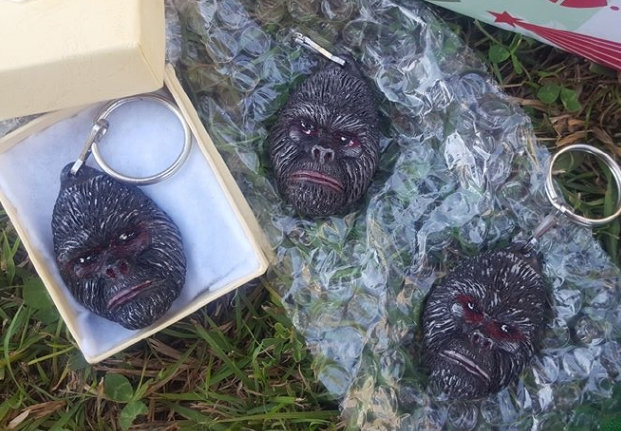
Two species – one human-like and the other gorilla-like – undiscovered at Coochin Creek? Sure, why not? Let’s be clear - this is cryptozoology and folklore in action not actual science. Yowie-researchers are doing it backwards - beginning with the premise that the Yowie exists as a real creature they then try to make the anomalous evidence fit. It doesn't.
After the meeting, I headed to the camping
spot at the nearby equestrian centre along with many of the speakers and enthusiasts for informal discussions around the campfire.
It is somehow easier for a wide variety of perspectives to mingle and exchange ideas in a casual face-to-face setting than it is via
online discussion where minor differences can quickly escalate to flame wars. Just being physically present seems to show a dedication
which breeds mutual respect. We are all after the same thing, are we not?
I had brought along some tough questions to pose to a couple
of researchers but I largely let them slide. The recent presentation didn’t warrant much in-depth analysis so I largely just enjoyed
being in the company of some interesting people with similar interests. Still, I was frank at times. When some were bemoaning the
lack of official academic interest in the subject I pointed out they had lots of subjective personal stories but a distinct lack of
objective evidence – photographic evidence being a prime example. What did they expect academics to be interested in? Ambiguous shapes?
If people are clearly seeing large hairy bipeds why are there no clear images? The “to-shoot-or-not-to-shoot” debate within the community
is somewhat ridiculous and potentially dangerous – Yowie enthusiasts shooting at ambiguous shapes in our state forests is a recipe
for disaster.
Without simple photographic evidence indicating there was an actual creature to be studied Yowie-research is still
at square one after more than 40 years of enquiry. Subjective human experiences with nothing objective to back them up. What little
evidence exists is derived from ambiguity. That might well be all there is to it but therein lies the problem. Seeing is believing
even when it arises from moments of ambiguity…
I was somewhat surprised when the wildlife speaker agreed with me while acknowledging
that in all his time in the bush he had never encountered any first-hand Yowie evidence and that even his own recent personal sighting
was ambiguous at best. Furthermore, he continued, eDNA has the potential to answer the question once and for all. Sources of eDNA
like hairs, skin cells, and various secretions collected from the soil, water sources, or even air can directly identify which creatures
are present in the environment. I haven’t always seen eye-to-eye with this guy on the Yowie but in this matter we are in agreeance.
Does
Yowie DNA exist? My best guess is no – but that won’t stop people from still seeing and otherwise experiencing the Yowie as real.
Besides, a deep undercurrent of not trusting science academics or government pervades the cryptozoological community. The mystery
will prevail. You’ll see…
Most of the night, however, was spent exchanging funny personal stories and there were some absolute beauties
– good and bad and ambiguous. The companionship was excellent and a credit to all involved. I will say that I did feel a somewhat
frosty reception from one particular fellow-enthusiast. I later learned that we had butted heads in online discussions several years
ago but by the end of the night I thought we were getting on well. In person he looks like Bill Murray and has a very similar sharp
dry wit which is easy to misconstrue in an online setting. I’d be keen to learn more about where he is at now with the Yowie…
In
conclusion, I would certainly attend again. It was fun as I think cryptozoology should be fun. The area is beautiful and I would love
to take an extra day to explore next time…


